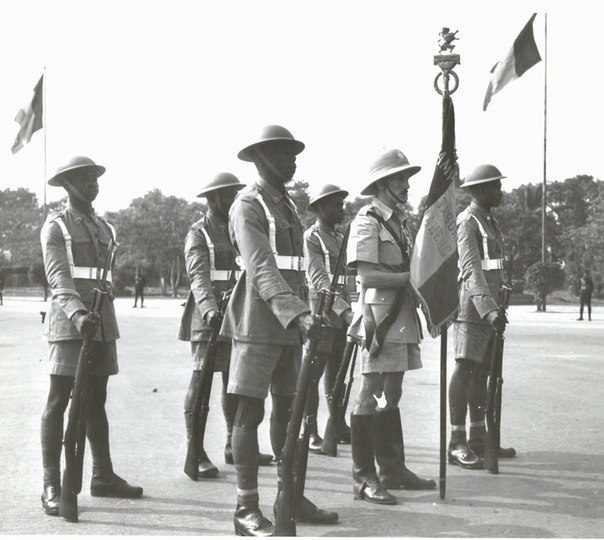Essa foto parece tratada. Encontrei uma outra versão:

Com mais algum acréscimo...

E os caras da Força Publica:
https://en.wikipedia.org/wiki/Force_Publique

Nunca nada é tão simples...
Atrocities
Under Leopold a major purpose of the Force was to enforce the rubber quotas and other forms of forced labor. Armed with modern weapons and the chicotte—a bull whip made of hippopotamus hide—soldiers of the FP often took and mistreated hostages. Reports from foreign missionaries and consular officials detail a number of instances where Congolese men and women were flogged or raped by soldiers of the Force Publique, unrestrained by their officers and NCOs. They also burned recalcitrant villages and there is evidence, including photographs, that FP soldiers cut off human hands either as trophies or to show that bullets had not been wasted.[3]
During the Free State period, the Force Publique suffered from institutional problems. During the early years of the force, mutinies of black soldiers occurred several times. By the early 1890s, much of the eastern portion of the Free State was under the control of Arab ivory and slave traders (though the Government was able to re-establish control over the east by the mid-1890s).[4] Organizational problems were also quite prevalent during the Free State era. With many Force Publique detachments being stationed in remote areas of the territory, some officers took to using soldiers under their control to further private economic agendas rather than focusing on military concerns.[5] By the end of 1891, the force had 60 officers, 60 non-commissioned officers, and 3,500 black soldiers. Friendly tribes and militias were often used to help exert control over the outermost parts of the Free State.[6]
Under Belgian ruleOrganisation and role
The Force Publique in German East Africa during World War I
Following the takeover of the Free State by the Belgian Government in 1908, the Force Publique was organised into 21 separate companies (originally numbered but were later known only by their names), along with an artillery and an engineers unit containing over 12,100 men. The companies were as follows: Aruwimi, Bangala, Bas-Congo, Cateracts, Équateur, Ituri, Kasai, Kwango, Lac Léopold II, Lualaba, Lulongo, Makrakas, Makua-Bomokandi, Ponthiérville, Rubi, Ruzizi-Kivu, Stanley Falls, Stanley Pool, Ubangi, and Uele-Bili.
There were also six recruit training camps containing over 2,400 men. These Force Publique companies eventually grew to over 600 men each but their constituent units known as detachments were so widely scattered that the force had no real military value. It was intended that each administrative company form a Compagnie Marche of 150 men. Each Marche or field company was intended to have four Belgian officers and NCOs plus between 100 and 150 askaris (African soldiers). In principle companies comprised two or three 50-man platoons. There were supposed to be enough companies to form three Marche battalions. There were eight Congolese NCOs as part of this establishment.
Belgian officers and NCOs replaced nearly all the multi-national Europeans who had been employed under the Free State. The 2,875 men of the Troupes de Katanga constituted a semi-autonomous force of six companies: four de marche and two other infantry, plus a cyclist company and a battalion headquarters. In addition there was the Compagnie d'Artillerie et de Génie (Artillery and Engineers Company) manning Fort Boma at the mouth of the Congo River in Boma. Fort Boma contained eight 160mm guns manned by 200 men, who saw little or no service during the war.
In 1914, the Force Publique, inclusive of the Katanga companies, totalled about 17,000 askaris with 178 white officers and 235 white NCOs. The majority served in small static garrisons called poste with a primarily police role. With the outbreak of World War I, the Katangese units were organized in battalions (Ie, IIe, and IIIme) for military service in Northern Rhodesia and the eastern frontier districts of the Congo. The FP was able to assemble another battalion from smaller units; originally called the IIIe but changed to the 11e to avoid confusion with the Katanga IIIme battalion.
Much had been done to remedy the worst excesses of the Free State period and the Force Publique had become a more typical colonial army — well disciplined but with an inevitably repressive role. Most askaris were armed with single shot 11 mm Albini Rifles. They continued to wear the blue uniform (with red trim around the neck and down the front opening), red fez and sash of the Free State period until replaced by khaki during 1915–17. Initial enlistment was for a period of seven years.
Other weapons included the Maxim machine-guns and Nordenfelt 4.7 cm and Krupp 7.5 cm cannons.